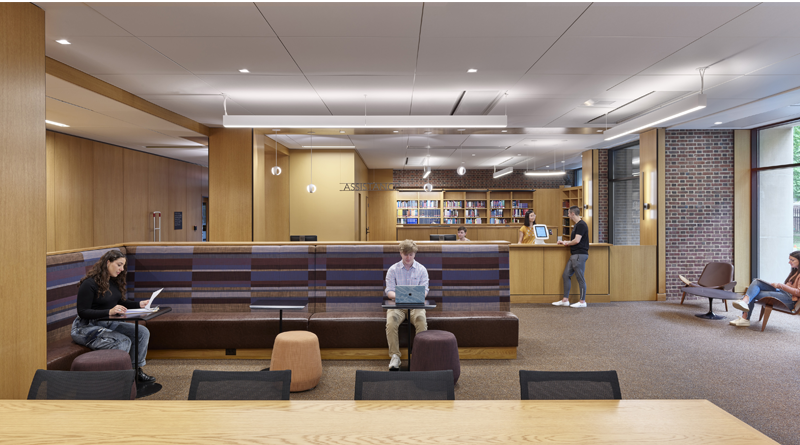Unique Transformation for University of Penn Science Library
By SCN Staff
PHILADELPHIA—The University of Pennsylvania’s Library System, Penn Medicine, and the Biology Department, sought to offer a radically new way of doing research, collaboration, and providing assistance to investigators. Voith & Mactavish Architects, LLP (VMA) was tasked with transforming the existing Biomedical Library and 8,000 sf of adjacent space into an open center for cross-disciplinary learning, prototyping, and collaboration. The redesigned space opened its doors to the public in September 2021.
The renovation rethinks what a university library can be in an era when book reference and individual research have given way to digital learning, hands-on making, and transdisciplinary exploration. Gone are the carrels and the stacks, replaced with tech-integrated conference spaces, collaboration classrooms with moveable furniture and boards, and a digital fabrication lab equipped with modeling tools and 3D printers.
Biotech Commons supports new modes of research by offering a range of spaces and services that better support how people learn and work. Students can schedule time in study rooms or book consultations in the makerspace. And unlike typical University libraries, Biotech Commons does not require a Penn ID for access on weekdays before 6PM, making it a barrier-free place that drives innovation by inviting professionals, students, and community members to collaborate.
To serve the diverse needs of its users, the renovated facility includes the Wendy and Wayne Holman Reading Room, which doubles as a multipurpose event space with movable furniture. The room accommodates a range of activities, including lecture-style events and open-space gatherings. It will also showcase the libraries’ historic collections. Similarly, the flexibly furnished Gershwind & Bennett Family Collaboration Classroom will host seminars, lecture-style presentations, and active, flipped-classroom style instruction.
The Judith and William Bollinger Digital Fabrication Lab provide 3D printing and poster printing services, equipped with nine high-end 3D printers and two 3D scanners, a laser cutter, and plotters for scientific poster printing. The Anatomage Table—the first of its kind at Penn—is available for use by all members of the Penn community, allowing for the virtual dissection and review of life-size virtual cadavers outside of clinical lab coursework.
At the heart of the space are clusters of adaptable group workspaces. Various seating options encourage different formats of collaboration, and 20 group study rooms accommodate between four and eight people each. The group study rooms are acoustically treated, allowing students to work together freely without disrupting others, but are centrally located so that students can see others working.
Achieving all this required both completely transforming the interiors and making considered changes to the exteriors. Housed in a brick structure from the late 1960s, the original library was unassuming, with dark interiors that felt cut-off from Hamilton Walk.
The renovation changes that, replacing the brick facade with floor-to-ceiling windows at ground level. The new windows open the building to the campus, allowing passersby on Hamilton Walk to see inside and bringing natural light to the once-gloomy interiors. Reading areas and lounges for informal group work line the windows, offering daylit spaces with views out to campus. The new library more fully leverages its location at the intersection of several University programs —including the Schools of Medicine, Nursing, Sciences, and Engineering—positioning Biotech Commons as a hub where scholars from these disciplines can exchange ideas.
The renovation was planned around the sensitive laboratory environments above and below Biotech Commons. The basement hosts a morgue and a Zebrafish laboratory—a space of floor-to-ceiling aquariums vulnerable to even minor sound vibrations. Above Biotech Commons are biomedical laboratories with specialized equipment served by glass pipes running through the building. VMA’s renovation took a surgical approach, reconfiguring the floor in the least invasive way possible and integrating new MEP systems without disturbing the sensitive surroundings.
Throughout, finishes were selected for durability, environmental friendliness, and ease-of-maintenance, lowering Biotech Commons’ lifecycle carbon footprint and operating costs. The building also hosts one of the first gender-neutral bathrooms on campus, advancing this university initiative.
VMA is a Philadelphia-based architecture firm whose work is founded on innovation within the context of tradition, a commitment to process, sustainability, and stewardship of the environment, and our focus on craftsmanship and beauty inform our work. Ever mindful of our stewardship of the built and natural environment we offer preservation services and all aspects of sustainable design.

